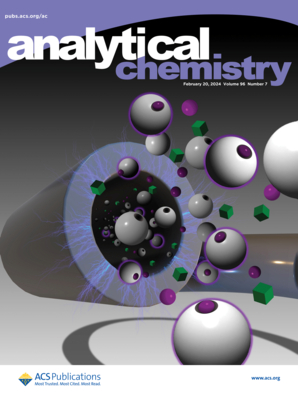一种新的单分子荧光寿命探针,通过线粒体SO2和DNA共同检测来诊断细胞凋亡。
IF 6.7
1区 化学
Q1 CHEMISTRY, ANALYTICAL
引用次数: 0
摘要
作为一种重要的信号分子,二氧化硫(SO2)在维持生理稳态中起着至关重要的作用。在这项工作中,我们设计了一种线粒体靶向荧光探针(MIC),用于实时独立检测SO2(短波长)和DNA(长波长)。值得注意的是,我们的研究揭示了SO2在调节氧化应激中的双重作用。在适当的水平下,它作为一种调节剂,而过量则通过降低线粒体膜电位、上调p53/Bax、下调Bcl-2和激活caspase-3级联来诱导细胞凋亡。凋亡过程诱导线粒体膜通透性改变,触发探针MIC释放和核易位,随后发出红色荧光。利用时间分辨荧光成像技术,我们进一步观察到DNA通道的平均荧光寿命显著增加。这一发现表明MIC探针不仅可以双通道监测线粒体SO2和核DNA,还可以通过荧光寿命的变化精确评估细胞凋亡过程。这一创新工具为深入研究二氧化硫介导的细胞凋亡机制提供了重要手段,并为线粒体相关疾病的诊断开辟了新的策略。本文章由计算机程序翻译,如有差异,请以英文原文为准。
A Novel Single-Molecule Fluorescence Lifetime Probe for Apoptosis Diagnosis Through Mitochondrial SO2 and DNA Co-Detection.
As a key signaling molecule, sulfur dioxide (SO2) plays a crucial role in maintaining physiological homeostasis. In this work, we designed a mitochondria-targeted fluorescent probe (MIC) for independently detect SO2 (short-wavelength) and DNA (long-wavelength) in real time. It is worth noting that our research reveals a dual role of that SO2 in regulating oxidative stress. At appropriate levels, it acts as a modulator, whereas excessive amounts induce apoptosis by reducing mitochondrial membrane potential, upregulating p53/Bax, downregulating Bcl-2, and activating the caspase-3 cascade. The apoptotic process induces mitochondrial membrane permeability changes, triggering the release and nuclear translocation of the probe MIC, which subsequently emits red fluorescence. Using time-resolved fluorescence imaging technology, we further observed a significant increase in the average fluorescence lifetime of the DNA channel. This finding demonstrates that the MIC probe not only enables dual-channel monitoring of mitochondrial SO2 and nuclear DNA but also precisely evaluates the apoptotic process through changes in fluorescence lifetime. This innovative tool provides an important means for in-depth study of the SO2-mediated apoptotic mechanism and opens up new strategies for the diagnosis of mitochondrial-related diseases.
求助全文
通过发布文献求助,成功后即可免费获取论文全文。
去求助
来源期刊

Analytical Chemistry
化学-分析化学
CiteScore
12.10
自引率
12.20%
发文量
1949
审稿时长
1.4 months
期刊介绍:
Analytical Chemistry, a peer-reviewed research journal, focuses on disseminating new and original knowledge across all branches of analytical chemistry. Fundamental articles may explore general principles of chemical measurement science and need not directly address existing or potential analytical methodology. They can be entirely theoretical or report experimental results. Contributions may cover various phases of analytical operations, including sampling, bioanalysis, electrochemistry, mass spectrometry, microscale and nanoscale systems, environmental analysis, separations, spectroscopy, chemical reactions and selectivity, instrumentation, imaging, surface analysis, and data processing. Papers discussing known analytical methods should present a significant, original application of the method, a notable improvement, or results on an important analyte.
 求助内容:
求助内容: 应助结果提醒方式:
应助结果提醒方式:


